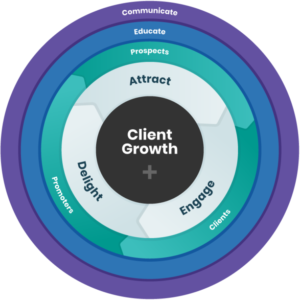Any organizations with disconnected marketing and sales will have trouble communicating. Marketing and sales pros have all seen it and it often works like this:
- The marketing team generates new leads and passes them to sales.
- Salespeople then try to sell to these leads—with no luck—and come back to the marketing team to let them know the leads were bad.
- Marketing assumes that the salespeople aren’t doing their job because the leads were fine, and sales concludes that marketing is just a gimmick that doesn’t work.
That’s a simplified account, but the basics are there. However, it doesn’t need to be this way. Smarketing, as coined by Dan Tyre at HubSpot, is the alignment of marketing and sales to make both more effective. The reason for the impasse described above is because sales and marketing teams aren’t communicating to work towards a common goal. We know that marketing and sales both work alone, but they work better together.
“The term ‘smarketing’ refers to alignment between your sales and marketing teams created through frequent and direct communication between the two. The goal is to have measurable goals that each team agrees to hit so there’s mutual accountability.” – HubSpot
So, if you’ve been wondering “why go HubSpot?” we’ve got your answer. HubSpot Marketing Hub and Sales Hub work in tandem to promote smarketing and improve results across the board for your entire organization. Let us show you how.
Table of contents
- HubSpot improves communication throughout your organization
- HubSpot tools that promote smarketing
- So, why go HubSpot?
HubSpot improves communication throughout your organization
Smarketing works because marketing and sales teams partner up rather than siloing themselves. This means that they work together to identify buyer personas, define the sales pipeline, and formalize lifecycle stages. HubSpot also enables these teams to pass additional information between departments, such as actions a lead takes on a website including clicks or form submissions.
All of this visibility really powers your inbound marketing and inbound sales initiatives. Everyone in your organization has what they need to generate the right types of leads, nurture them, and convert them into delighted customers. If this sounds a lot like the inbound flywheel to you, then you’d be correct.
The inbound flywheel connects marketing and sales teams
Take a look at the flywheel. We prefer it to the traditional marketing funnel because it helps us visualize marketing and sales unified in their efforts, rather than completely separate processes.

See, marketing teams are responsible for attracting leads. They use a variety of tactics to accomplish this, like social media marketing, SEO, content marketing, and more. Those leads are nurtured along at the start of their buyer’s journey through marketing. Lead nurturing tactics can include email marketing, webinars, content offers, and other information these people find valuable.
At some point, leads will take an action that makes them sales-qualified. (At least, that’s the goal. Some leads never become SQLs, which is why it’s so important to define lifecycle stages. More on that in a bit…) Marketing then passes these SQLs to the sales team to continue to nurture and convert into customers. SQLs that don’t convert are passed back to the marketing team.
What happens when a lead becomes a customer? We certainly don’t want to forget about them. It’s important for businesses to continue to delight these customers through ongoing support, information sessions, promotions, and more. Happy, loyal customers become our best promoters through word-of-mouth marketing and reviews. Thus, we add momentum to the spinning flywheel.
Throughout this process you’ll see that the roles of marketing and sales overlap at multiple touchpoints, highlighting the importance of communication between teams. HubSpot facilitates this communication—even in the day and age of remote work.
HubSpot tools that promote smarketing
So, we’ve broken down the inbound flywheel and explained why smarketing—the alignment of marketing and sales—is so important. By now you’re probably asking, “Okay, but how do I accomplish this?”
Luckily, it’s no longer necessary to hold long weekly meetings or push our desks together in the office (although sometimes we wish we could still sit next to each other…). HubSpot offers many tools and features that streamline communication between teams. After implementation, these tools are fully equipped with all the information team members need to do their jobs well.
Buyer personas tool
Buyer personas are at the core of any inbound strategy. They explain a brand’s ideal customer, their pain points, goals, challenges, and the questions they’re asking. Depending on your business type, you may have three or more buyer personas that you’ll target with your marketing efforts.
Your buyer personas shouldn’t be a set-it-and-forget-it type of thing. Once you’ve developed them, you need to put them into practice. In HubSpot, under Settings and Properties, you can add your personas and their details for everyone in your account to see. Not only is it a helpful record, but these properties can also be baked into forms, allowing users to self-select their personas when they submit forms on your landing pages. From there, marketing teams can tailor their lead nurturing efforts based on buyer personas and offer more relevant information to leads. Sales teams will also have great insight into an SQL’s needs, questions, and goals based on their associated buyer persona.
HubSpot lifecycle stages
Similar to buyer personas, lifecycle stages help marketing and sales teams make more informed decisions. There are default lifecycle stages provided by HubSpot, but they can (and should!) be tailored to meet your unique business and sales process.
- Subscriber: Contacts who know of your business and have signed up for some form of communication.
- Lead: Contacts who have shown sales-readiness through signing up for a content offer or downloading a resource.
- Marketing Qualified Lead (MQL): Contacts who have engaged with marketing efforts but aren’t ready to receive a sales call.
- Sales Qualified Lead (SQL): Contacts who have indicated through their actions that they are ready for a direct sales follow up.
- Opportunity: Contacts who are real sales opportunities.
- Customer: Contacts with closed deals.
- Evangelist: Customers who advocate for your business and whose networks may be leveraged for more leads.
- Other: A wildcard stage that can be used when a contact does not fit any of the above stages.
It’s critical for sales and marketing to agree on the definitions for each of these lifecycle stages in the context of their business. This alignment will ensure that marketing teams generate “good” leads and pass on SQLs to sales when they’re ready to make a purchase. For optimal results, defining lifecycle stages should be a collaborative effort.
HubSpot sales pipeline
HubSpot defines it best:
“A sales pipeline encompasses every stage of your sales process. An opportunity moves from stage to stage of your pipeline based on concrete actions, which is usually represented visually in your CRM. Because sales processes differ from company to company (and even product to product), your sales pipeline should be unique and reflect the typical buyer’s journey.” – HubSpot
Your sales pipeline outlines every stage of your sales process and visually represents opportunities as they move through the pipeline to become customers. Not only does it help salespeople see how many opportunities are currently in the pipeline, but it also gives marketing teams visibility into which SQLs actually convert.
The sales pipeline also acts as a resource for decision-makers beyond marketing and sales teams. It provides accurate revenue forecasting—granted that it’s set up correctly—so leaders can make strategic decisions. Depending on the number of deals moving through the pipeline, leaders may find it necessary to hire more staff or adjust the marketing budget to better meet business goals.
So, why go HubSpot?
Any good relationship is built of communication, so why should a business be an exception? Communication and alignment towards goals—smarketing, if you will—between marketing and sales teams are the foundation for success. Thankfully, HubSpot empowers teams to collaborate and communicate more effectively, which benefits the entire organization.
Want to see more results from HubSpot? Check out our case studies to learn how we’ve helped our clients smash their goals and get the most out of their marketing tech stack.





